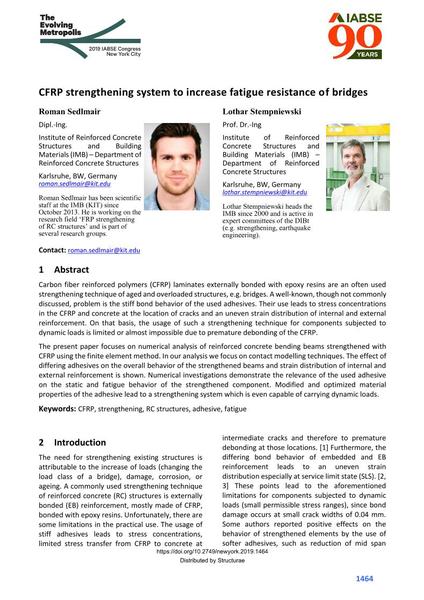CFRP strengthening system to increase fatigue resistance of bridges

|
|
|||||||||||
Détails bibliographiques
| Auteur(s): |
Roman Sedlmair
(Institute of Reinforced Concrete Structures and Building Materials (IMB) – Department of Reinforced Concrete Structures)
Lothar Stempniewski (Institute of Reinforced Concrete Structures and Building Materials (IMB) – Department of Reinforced Concrete Structures) |
||||
|---|---|---|---|---|---|
| Médium: | papier de conférence | ||||
| Langue(s): | anglais | ||||
| Conférence: | IABSE Congress: The Evolving Metropolis, New York, NY, USA, 4-6 September 2019 | ||||
| Publié dans: | The Evolving Metropolis | ||||
|
|||||
| Page(s): | 1464-1468 | ||||
| Nombre total de pages (du PDF): | 5 | ||||
| DOI: | 10.2749/newyork.2019.1464 | ||||
| Abstrait: |
Carbon fiber reinforced polymers (CFRP) laminates externally bonded with epoxy resins are an often used strengthening technique of aged and overloaded structures, e.g. bridges. A well-known, though not commonly discussed, problem is the stiff bond behavior of the used adhesives. Their use leads to stress concentrations in the CFRP and concrete at the location of cracks and an uneven strain distribution of internal and external reinforcement. On that basis, the usage of such a strengthening technique for components subjected to dynamic loads is limited or almost impossible due to premature debonding of the CFRP. The present paper focuses on numerical analysis of reinforced concrete bending beams strengthened with CFRP using the finite element method. In our analysis we focus on contact modelling techniques. The effect of differing adhesives on the overall behavior of the strengthened beams and strain distribution of internal and external reinforcement is shown. Numerical investigations demonstrate the relevance of the used adhesive on the static and fatigue behavior of the strengthened component. Modified and optimized material properties of the adhesive lead to a strengthening system which is even capable of carrying dynamic loads. |
||||
| Mots-clé: |
renforcement
|
||||
